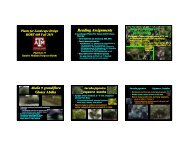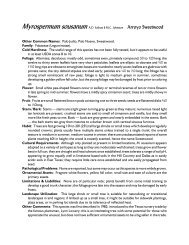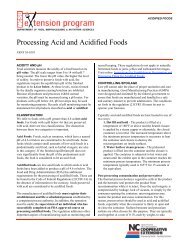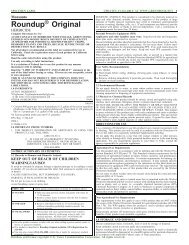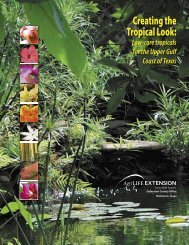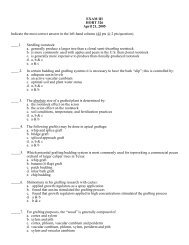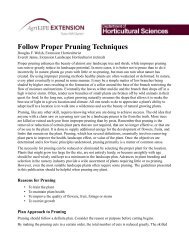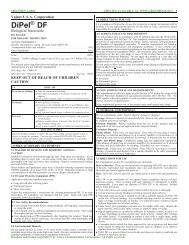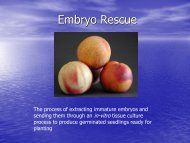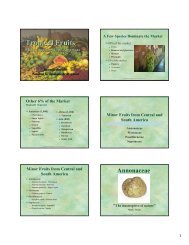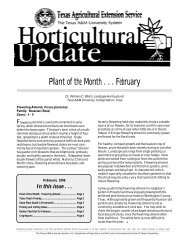Guide to PAS 2050 How to assess the carbon ... - Aggie Horticulture
Guide to PAS 2050 How to assess the carbon ... - Aggie Horticulture
Guide to PAS 2050 How to assess the carbon ... - Aggie Horticulture
Create successful ePaper yourself
Turn your PDF publications into a flip-book with our unique Google optimized e-Paper software.
<strong>Guide</strong> <strong>to</strong> <strong>PAS</strong> <strong>2050</strong> 37<br />
Section III<br />
Next steps<br />
Depending on <strong>the</strong> objectives for <strong>the</strong> <strong>assess</strong>ment,<br />
several different actions may be taken once a product<br />
<strong>carbon</strong> footprint has been calculated. Organisations<br />
that are only using <strong>PAS</strong> <strong>2050</strong> <strong>to</strong> guide a high-level<br />
analysis may want <strong>to</strong> move straight in<strong>to</strong> identifying<br />
emission reduction opportunities. O<strong>the</strong>rs may want <strong>to</strong><br />
verify <strong>the</strong> footprint method and number, ei<strong>the</strong>r <strong>to</strong><br />
provide more confidence in <strong>the</strong>ir own internal decision<br />
making or as a step <strong>to</strong>wards making external claims.<br />
Validating results<br />
In general, it is useful <strong>to</strong> verify <strong>the</strong> product <strong>carbon</strong><br />
footprint in order <strong>to</strong> ensure any actions or decisions<br />
are made on <strong>the</strong> basis of a correct and consistent<br />
analysis. <strong>How</strong>ever, <strong>the</strong> level of verification necessary<br />
depends on <strong>the</strong> project goals – for communication <strong>to</strong><br />
cus<strong>to</strong>mers, a higher level of verification is needed than<br />
if <strong>the</strong> data is only be used internally.<br />
<strong>PAS</strong> <strong>2050</strong> specifies three levels of verification depending<br />
on how <strong>the</strong> product <strong>carbon</strong> footprint will be used (see<br />
<strong>PAS</strong> <strong>2050</strong> Section 10.3 for more information):<br />
1. Certification – independent third party certification<br />
body accredited by an internationally recognised<br />
accreditation body (e.g. United Kingdom<br />
Accreditation Service, UKAS). Here, an audi<strong>to</strong>r will<br />
review <strong>the</strong> process used <strong>to</strong> estimate <strong>the</strong> <strong>carbon</strong><br />
footprint, check <strong>the</strong> data sources and calculations<br />
and certify whe<strong>the</strong>r <strong>PAS</strong> <strong>2050</strong> has been used<br />
correctly and whe<strong>the</strong>r <strong>the</strong> <strong>assess</strong>ment has achieved<br />
conformity. This is advisable for external<br />
communication of <strong>the</strong> footprint results and may be<br />
desirable in any case, <strong>to</strong> ensure decisions are<br />
made on <strong>the</strong> basis of correct information.<br />
2. O<strong>the</strong>r-party verification – non-accredited third<br />
parties should demonstrate compliance with<br />
recognised standards for certification bodies and<br />
provide for external validation on request. This<br />
approach may not offer <strong>the</strong> level of confidence that<br />
fully accredited certification bodies can provide.<br />
3. Self-verification – if choosing <strong>to</strong> self-verify, follow<br />
<strong>the</strong> method outlined in BS EN ISO 14021 6) . Note<br />
that users of <strong>the</strong> footprint may have lower<br />
confidence in this option.<br />
Independent certification is highly encouraged when<br />
companies want <strong>to</strong> communicate <strong>the</strong> <strong>carbon</strong> footprint<br />
publicly. Third party certification by accredited experts<br />
also provides peace of mind that any subsequent<br />
decisions made (e.g. <strong>to</strong> reduce emissions and costs,<br />
choose suppliers, change receipts and discontinue<br />
products) are supported by robust analysis.<br />
Different product footprints are not truly comparable<br />
unless <strong>the</strong> same data sources, boundary conditions<br />
and o<strong>the</strong>r assumptions are used.<br />
Reducing emissions<br />
Product <strong>carbon</strong> footprints can provide valuable<br />
insights <strong>to</strong> help reduce GHG emissions. The<br />
footprinting exercise both provides a baseline against<br />
which <strong>to</strong> measure future reductions and helps identify<br />
opportunities <strong>to</strong> reduce emissions across all phases of<br />
<strong>the</strong> product’s life cycle. The analysis offers a way <strong>to</strong><br />
6)<br />
BS EN ISO 14021, Environmental labels and declarations —<br />
Self-declared environmental claims (Type II environmental labelling).




